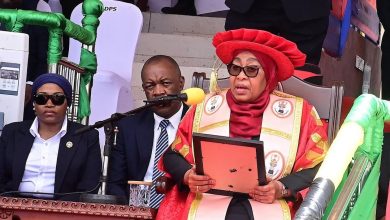When one story becomes the whole story

DAR ES SALAAM: THE New York Times’ recent article on Tanzania’s 2025 election tells a dramatic story of violence, repression and an implausibly lopsided electoral outcome.
Yet the danger of a single story, especially one written from afar, is that it compresses a nation’s complex political reality into a neat narrative that satisfies readers, but fails to illuminate the truth.
Tanzania deserves more than that
“When a story is simplified, a nation is misunderstood.”
CCM politics, the intensity of factional rivalries, regional balancing, the long arc of historical party dominance, and the internal contradictions of civic movements cannot be reduced to a single narrative of “government attacks protesters.”
Reality is more complex, and often more inconvenient for those trying to frame events as black-and-white.
The Missing context: Tanzanian politics is not a one-axis story
The NYT article focuses almost exclusively on the actions of the government. Missing is the political ecosystem beneath: The fragmentation of the opposition and the rise of parallel movements.
The generational shift in civic activism — digitally coordinated, emotionally charged, often leaderless.
The role of misinformation and online mobilisation is intensifying tensions before election day. The internal competition within CCM, often shapes outcomes more than external pressures.
This omission leads international audiences to believe that political violence in Tanzania is a simple product of government repression, ignoring the broader contestations — both within the ruling party and the opposition movements.
Casualty numbers: Between tragedy and hyperbole
Tragic losses occurred. Families are grieving. Tanzanians are mourning. Adversaries are cheering.
But in both domestic and global circles, the casualty numbers have varied wildly, ranging from a handful of deaths to sensational claims of hundreds or even thousands. These numbers circulated rapidly — often unverified — and were quickly adopted as political ammunition.
“The truth deserves precision, not exaggeration.
” Would it be wise for affected families to come forward with verified lists of their loved ones? Morally — yes.
Politically — it risks being weaponised. Socially — it could expose them to intimidation or trauma.
The real question is: Who benefits from inflating these figures? Certainly not the families. Obviously, the adversaries.
Who initiated the violence? The NYT omits the first spark
A critical omission in the NYT narrative is the role of the “No Reform, No Election” movement — a campaign that publicly and repeatedly encouraged supporters to “kunukisha” (disrupt the process) on election day.
This is not speculation. It was openly stated. Documented online. Repeated in rallies and on social media.
The NYT frames the unrest as government-initiated — yet substantial evidence suggests violent disruptions were being organised long before the polls opened, aimed at delegitimising the election and provoking international condemnation.
“Violence is never spontaneous. It is organised somewhere, by someone, for a purpose.”
The government’s security response, while forceful and not without faults, did not manifest in a vacuum. It was triggered by deliberate attempts to destabilise the polling environment and create viral imagery of chaos for external consumption.
But the NYT treats government response as the starting point — not the deescalation point. Should the government become a bystander and let communities, cities and the nation burn and turn into ashes?
The real root cause: A contest between two political visions
To understand what happened on the October 2025 election day, the question is not: “Who shot first?” But rather: “Who engineered conditions for violence weeks before?”
“Who stood to gain from a delegitimised election?” “Why did calls for chaos intensify as election day approached?”
Tanzania is currently confronting a political war of narratives: One narrative insists the government is suppressing democracy.
Another argues that the opposition movement is intentionally provoking government forces to claim martyrdom.
The truth lies somewhere in the middle — and closer examination suggests Tanzania is not dealing with simple repression, but with a power struggle between two competing strategies: Institutional continuity (CCM, government apparatus). Narrativedriven disruption (“No Reform, No Election”).
This battle is not just for votes — but for legitimacy. The pipeline ahead: Violence as a political strategy?
The most concerning development is that violence did not end with the election. It is being signalled as part of the next phase — rumours of planned disruptions around Independence Day are circulating.
If pre-election chaos was meant to delegitimise results, then post-election chaos may be aimed at challenging national symbols and provoking a crisis.
This is the story the NYT did not tell. This is the story Tanzanians are living with. “If violence becomes a strategy, then democracy becomes a victim.”
Conclusion—Tanzania deserves better reporting — and better debate
Tanzania’s political reality is not captured by a single-story narratives, whether domestically or internationally.
It is shaped by: Structural tensions within CCM, opposition fragmentation, civic radicalisation, misinformation, regional dynamics, generational grievances and yes — government responses.
But to blame only one side is to blind oneself to the full landscape. The New York Times article raises legitimate concerns — yet its selective framing reinforces a simplistic storyline that neither honours the truth nor respects the complexities Tanzanians are navigating.
Our nation deserves rigorous reporting, not dramatic; balanced, not sensational; contextualised, not detached.
ALSO READ: Tanzania safe, stable ready for visitors
And more importantly, we deserve to confront our issues with honesty — not political manipulation or misinformation.






NYTimes..PLEASE it’s 2025..learn something sometime
Excellent and professionally analysis of political situation in Tanzania
Really? Then why all the attempts to cover up the real situation? Why close down the Internet for days?There are people who are known to have disappeared without a trace and there is a lot of anger and fear among Tanzanians. The author sounds like a Government apologist.
I think you should read again the post, always.
The true message lies in the author’s intention, not merely in the words written.
You should read again and this time try to understand the author’s intention.